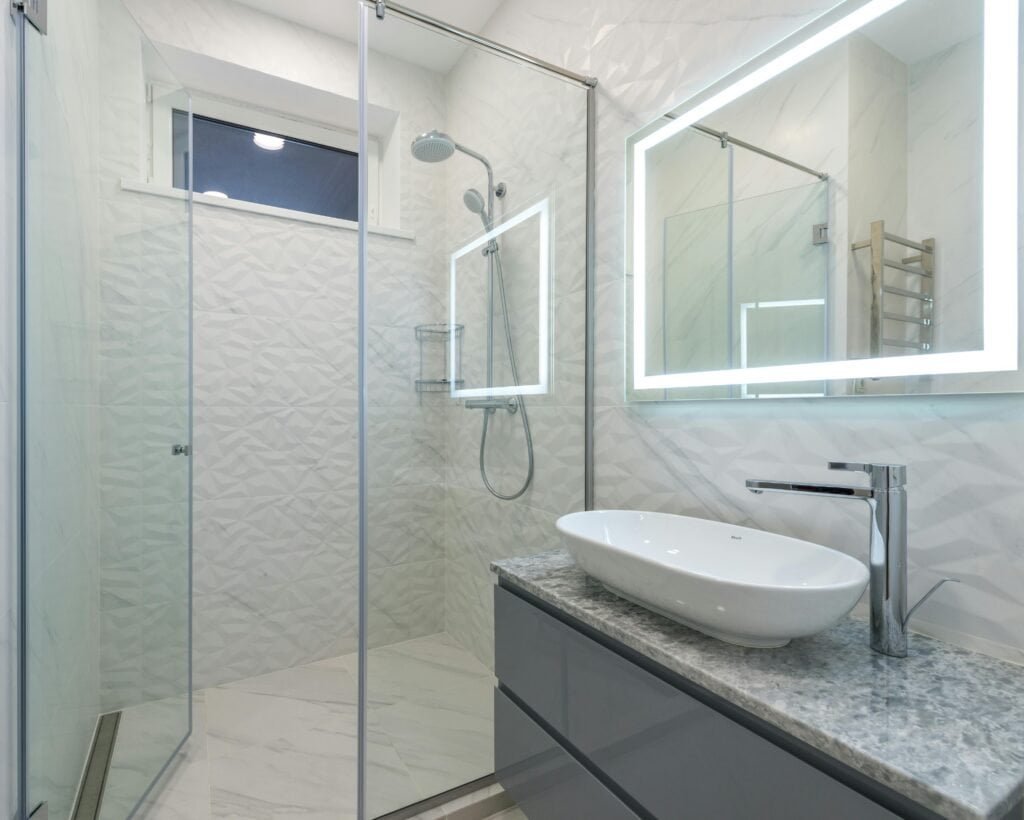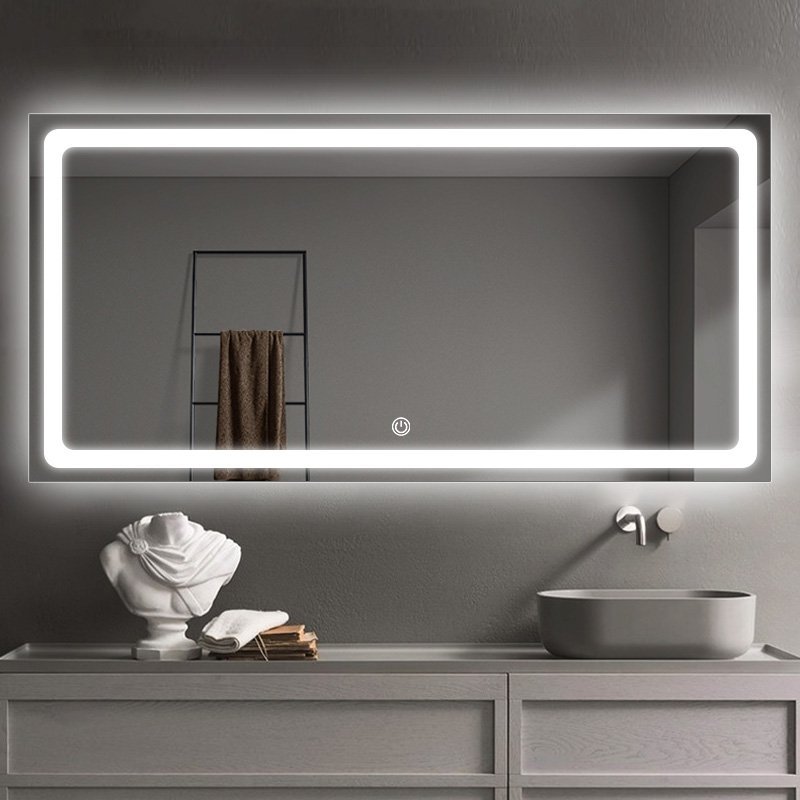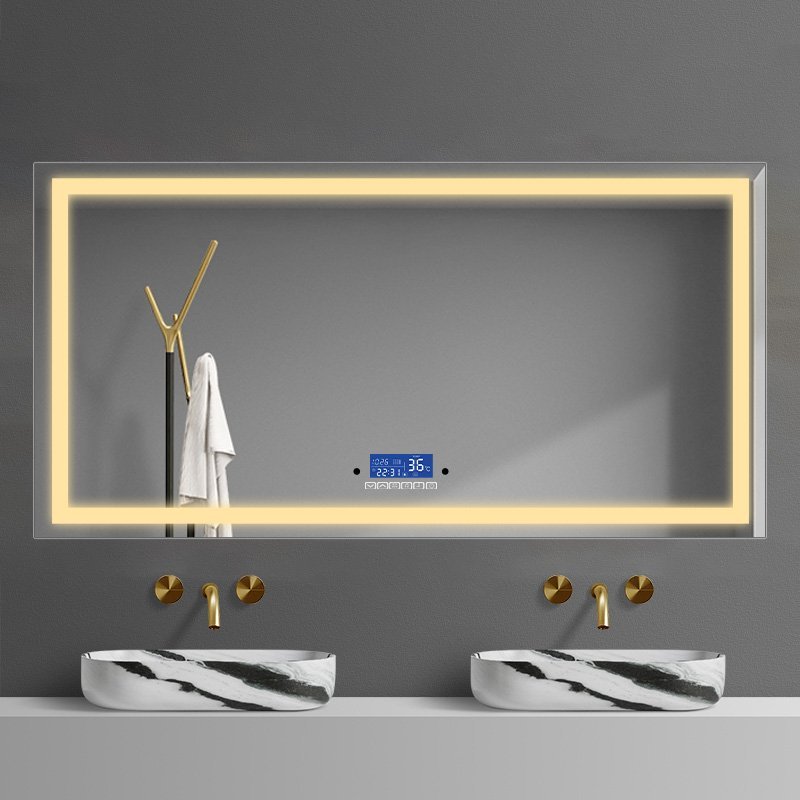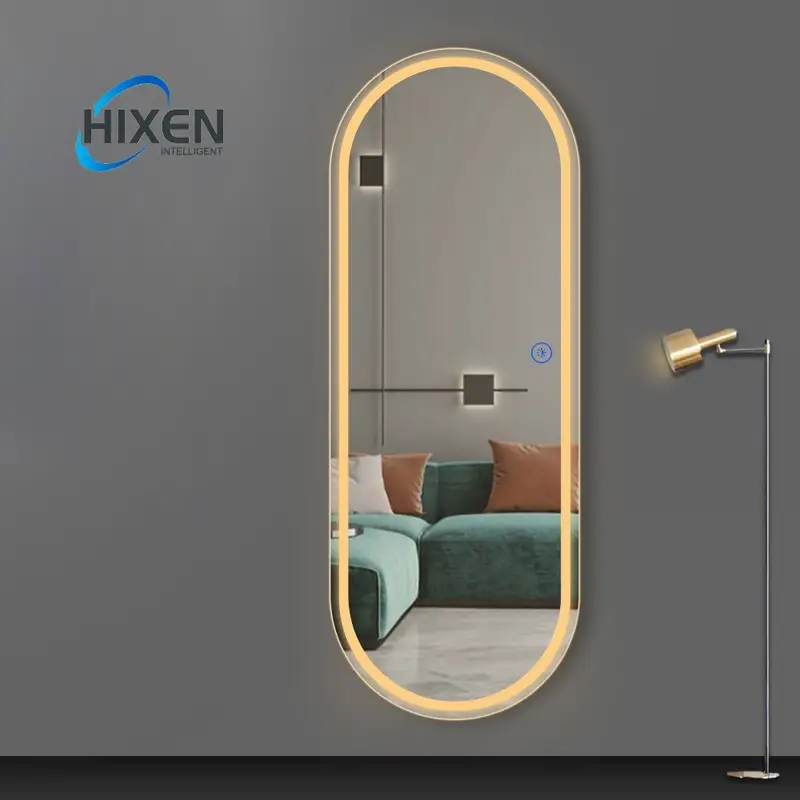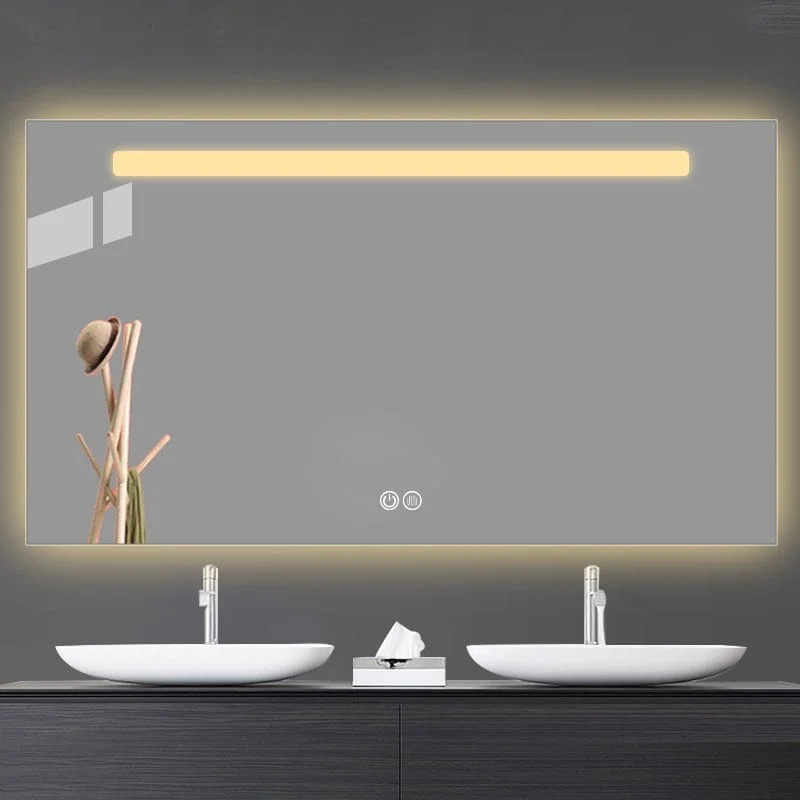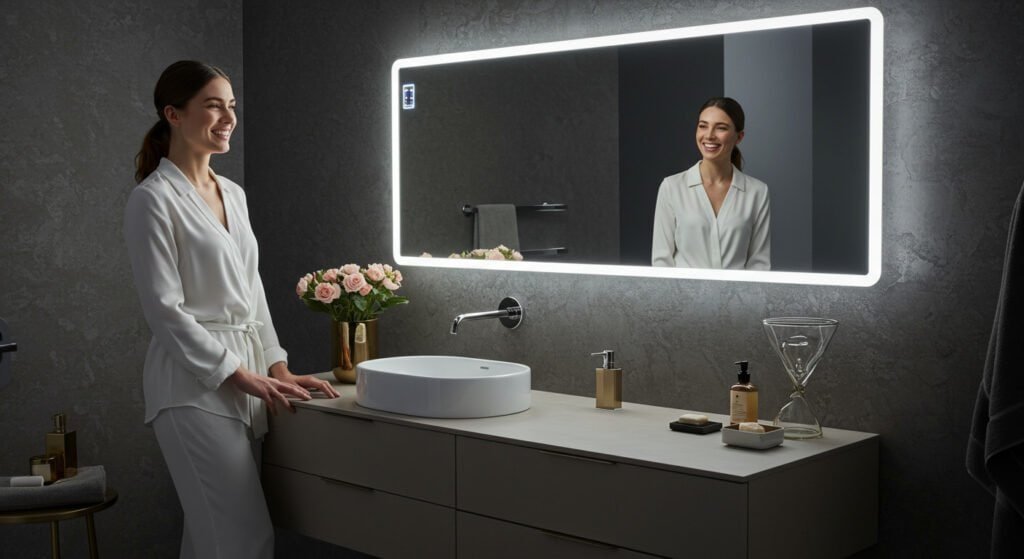How do anti fog mirrors work? Nothing is more annoying than stepping out of a hot shower and finding your bathroom mirror completely fogged up. You need to see yourself clearly, but the foggy mirror bathroom surface makes it impossible, and wiping it only helps for a few seconds before it fogs up again.
Anti-fog mirrors solve this problem using two main approaches. The first method uses a heating system behind the mirror that keeps the glass warm enough to stop fog from forming. The second method applies a special anti fog mirror coating that changes how water behaves on the mirror surface. Both technologies prevent the condensation that causes your bathroom mirror foggy appearance, giving you a clear reflection immediately after showering.
Let’s explore exactly how these systems work and which solution makes the most sense for your bathroom.
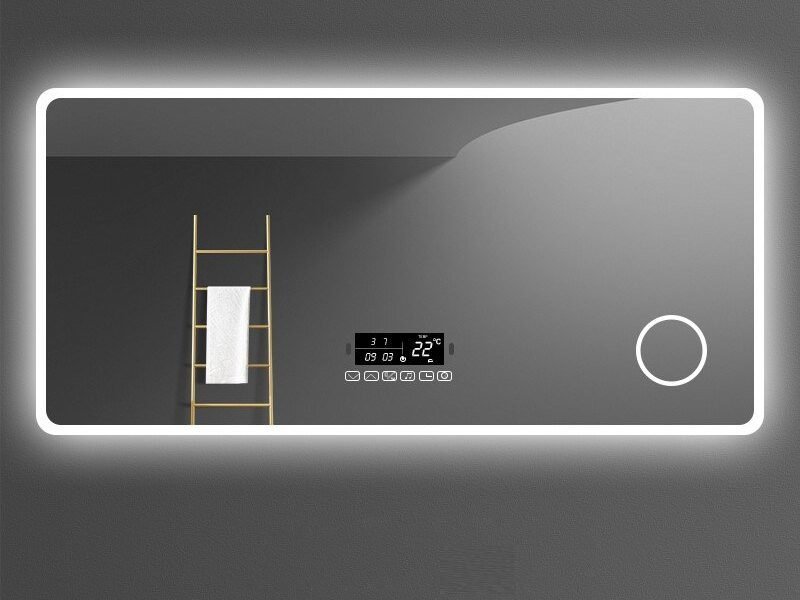
What Causes Bathroom Mirrors to Fog Up?
Understanding why mirrors fog helps you choose the best prevention method and use it effectively.
Mirrors fog when warm, moist air from your shower touches the cold mirror surface, causing invisible water vapor to turn into tiny water drops that block your view. This happens because the cold mirror cools down the air right next to it, and cool air cannot hold as much moisture as warm air.
Think of it like what happens to a cold drink on a hot day. When you take a glass of ice water outside in summer, water droplets form on the outside of the glass. The same process happens with your bathroom mirror. عندما تستحم, the bathroom fills with hot steam. This steam contacts your cool glass mirror and immediately turns into thousands of tiny water droplets. These droplets scatter light in all directions instead of reflecting your image back to you, which is why the mirror looks white and cloudy.
The bigger the temperature difference between the hot bathroom air and the cold mirror, the faster and thicker the fog becomes. Your mirror stays cold because it is often mounted against a wall that stays cool, especially if that wall faces outside. Even modern lighted bathroom mirror designs can stay cool enough to fog up because the lights typically only warm a small portion of the mirror frame, not the glass itself. After your shower ends, the mirror gradually warms up from the hot bathroom air, and the fog slowly disappears. لكن, this natural process usually takes five to fifteen minutes, which is far too long when you need to get ready quickly.
What Happens to the Bathroom Mirror After You Take a Shower?
The fogging process follows a predictable pattern that you have probably noticed many times without thinking about the details.
As soon as you start your shower, moisture begins collecting on the mirror surface in small droplets that quickly spread and merge together to create a thick fog layer that completely blocks your reflection.
The fog appears within seconds of turning on hot water because the temperature change happens so rapidly. At first, you might see just a light haze on your led bathroom mirror, but this quickly becomes a complete white coating. The water droplets are actually quite small, roughly the size of tiny dust particles, but there are millions of them covering every square inch of mirror surface. As your shower continues, the fog gets thicker because more water keeps condensing on the already wet surface. Some mirrors even get wet enough that water starts running down in streams.
When you finish showering, the mirror does not clear up right away. The glass needs time to warm up to match the hot bathroom air temperature. A small bathroom mirror clears faster than a large bathroom vanity mirror because smaller surfaces warm more quickly. Ventilation makes a huge difference too. If you run an exhaust fan or open a window, the fog clears much faster because you are removing the humid air and bringing in drier air. Without good ventilation, you might wait ten minutes or longer before your mirror is clear enough to use. This waiting time is exactly why anti-fog technology has become so popular in modern bathroom design.

How Does Heated Anti-Fog Technology Work?
Heated anti-fog systems use a simple but effective approach that keeps your mirror clear from the moment you turn on your shower.
A heated anti-fog mirror contains a thin electric heating pad attached to the back of the mirror glass that warms the surface just enough to stay warmer than the bathroom air, which stops water vapor from condensing into fog droplets.
The heating pad is surprisingly thin, usually less than a quarter inch thick, and covers most of the mirror surface behind the glass. When you turn it on, the pad heats the mirror glass to roughly 95 ل 105 degrees Fahrenheit, which is just slightly warm to the touch. This temperature is carefully chosen because it needs to be warm enough to prevent fog but not so hot that it wastes energy or creates a safety concern.
The key concept is staying above what scientists call the dew point, which is the temperature at which water vapor turns into liquid water. By keeping the mirror surface warmer than the dew point, water vapor simply stays as invisible gas instead of forming visible droplets. Most heated mirrors connect directly to your bathroom electrical system and draw very little power, typically between 20 ل 50 watts, which is less than a standard light bulb.
Many modern anti fog bathroom mirror with light products integrate the heating system with the LED lighting, so both features connect to a single switch. The heating pad usually takes two to three minutes to warm up fully, so some people turn on their bathroom light mirror before starting their shower. The system is completely safe because the heating element is sealed behind the mirror glass and uses low voltage similar to heated car seats. Quality heated mirrors also include automatic shutoff features that prevent overheating.
What Is Anti-Fog Coating and How Effective Is It?
Anti-fog coatings offer a completely different approach that works without any electricity or heating elements.
Anti fog mirror coating uses special chemicals that make the mirror surface attract water molecules, spreading them into a thin, transparent sheet instead of allowing them to form cloudy droplets that block your view.
Regular mirror surfaces naturally repel water, which is why water forms into distinct droplets. Coating changes this property by creating what scientists call a hydrophilic surface, which literally means water-loving. When water vapor hits a coated mirror, the coating pulls the water molecules outward across the surface in an extremely thin layer. This layer is so thin that light passes through it easily, which means you can still see your reflection clearly even though there is technically water on the mirror. It is similar to how a freshly cleaned car windshield sheds water better than a dirty one.
The coating changes the surface tension of water, which determines how water behaves when it contacts a solid surface. These coatings come in two forms: permanent factory-applied treatments that are baked into the mirror during manufacturing, and spray-on products that you can apply yourself at home. Factory coatings generally last much longer, often maintaining effectiveness for several years with proper care. The best anti fog spray for bathroom mirror applications typically lasts several weeks to a few months before requiring reapplication.
لكن, coatings gradually wear away over time, especially when you clean the mirror with harsh chemicals or abrasive materials. Compared to heated systems, coatings have advantages and disadvantages. They cost less initially and require no electricity, but they need regular maintenance and eventually lose effectiveness. A lighted vanity mirror with factory anti-fog coating offers convenience without ongoing maintenance, while spray treatments give you flexibility but require your attention to maintain performance.
Do Anti-Fog Mirrors Need Electricity?
The power requirements depend entirely on which anti-fog technology your mirror uses, and understanding this helps you plan installation correctly.
Heated anti-fog mirrors require electrical connection because they use heating elements to warm the mirror surface, while mirrors with anti-fog coating work without any power because they rely purely on chemical surface treatment.
If you are considering a heated bathroom mirror, you should know that the electrical requirements are straightforward and similar to installing vanity lights. The mirror connects to your home electrical system through standard wiring, typically the same circuit that powers your bathroom lighting. Most heated mirrors operate on standard 110 ل 120 volt household current and consume minimal power. To put the energy use in perspective, running a heated mirror for an hour uses less electricity than running a hair dryer for five minutes.
Many modern led mirror designs incorporate the heating function directly into the mirror assembly along with the lighting system, so your electrician only needs to make one electrical connection for both features. The installation process typically requires professional work unless you have electrical experience, because it involves working with your home wiring system. لكن, once installed, operation is completely simple, usually just a touch button or switch activation.
Some advanced models include motion sensors that automatically turn on the heating when you enter the bathroom, or timers that warm the mirror before your typical shower time. على الجانب الآخر, mirrors with anti-fog coating need no electrical work at all. You can hang them exactly like regular bathroom vanity mirrors using standard mounting hardware. This makes coating-based mirrors easier to install and more flexible for placement, since you are not restricted by electrical outlet locations. For renters or people who want to avoid electrical work, a coated wall mirror with lights that has separate anti-fog spray application offers a good compromise.

How Anti-Fog Mirrors Work and Tips for Usage
Getting the best performance from your anti-fog mirror requires understanding a few simple usage principles that maximize effectiveness.
For heated mirrors, turn on the heating function two to three minutes before showering to allow the mirror surface to reach optimal temperature, and for coated mirrors, maintain the coating by cleaning gently with recommended products and reapplying treatment as needed.
Heated mirror users often make one common mistake by expecting instant results. While the mirror heats relatively quickly, starting the heating process before you shower ensures the entire surface reaches the right temperature. Think of it like preheating an oven before cooking. Some people create a routine where turning on their lighted vanity mirrors for bathroom becomes the first step of their morning preparation, giving the heating system time to work while they prepare other things.
Also important is keeping the mirror surface clean, because dirt, soap residue, and mineral deposits can interfere with even heating and create patches where fog forms despite the heating pad working correctly. Use a soft cloth with gentle glass cleaner, avoiding abrasive materials that might scratch the surface. For coated mirrors, proper maintenance becomes even more critical because the coating itself provides all the anti-fog protection. When cleaning your anti fog bathroom mirror Reddit users often recommend specific gentle cleaners that do not strip away the coating, such as plain water with a microfiber cloth or specifically designed coating-safe cleaners.
Avoid ammonia-based cleaners or anything with harsh chemicals. If you notice your coating starting to lose effectiveness, reapply anti-fog spray following the product instructions carefully, which usually means cleaning the mirror thoroughly, applying the spray evenly, and allowing adequate drying time. Both mirror types benefit from good bathroom ventilation, not because they need help preventing fog, but because reducing overall humidity protects the mirror components and mounting hardware from moisture damage over time.
Why Is My Anti-Fog Mirror Fogging Up?
When an anti-fog mirror starts fogging, the problem usually has a simple cause that you can identify and fix yourself.
The most common reasons anti-fog mirrors fog up include electrical connection problems for heated mirrors, worn coating on treated mirrors, dirty mirror surfaces that interfere with anti-fog function, or heating systems that are not powerful enough for extremely humid conditions.
For heated mirrors, always check the power connection first. Verify that the mirror is actually turned on, because this obvious step is easy to overlook in your morning routine. Check if the switch feels warm after being on for a few minutes, which indicates the heating system is working. If nothing seems to be happening, inspect the electrical connection or circuit breaker to ensure power is reaching the mirror.
Sometimes connections work loose over time, especially if the mirror experienced any movement or vibration. If your backlit mirror has worked perfectly for months and suddenly stops preventing fog, this electrical issue is the most likely culprit. For coated mirrors, performance degradation over time is completely normal and expected. Factory-applied coatings typically last several years but eventually wear down from repeated cleaning and water exposure. Spray-applied coatings need reapplication every few weeks to several months depending on product quality and usage frequency.
Test whether coating is the problem by thoroughly cleaning the mirror and applying fresh anti-fog treatment. If this restores clear performance, you know the coating simply needed renewal. Another often-overlooked problem is surface contamination. Hairspray, cosmetic products, soap splashes, and hard water mineral deposits all create a barrier between the anti-fog system and the water vapor trying to condense. This contamination can make even properly functioning systems appear to fail.
A thorough cleaning with appropriate products often resolves the issue immediately. أخيراً, extremely humid conditions can overwhelm even good anti-fog systems. If you take extremely long, hot showers in a small bathroom with no ventilation, you create humidity levels that exceed what standard anti-fog technology can handle. In these cases, improving ventilation by running exhaust fans or opening doors typically solves the problem.

Does Toothpaste Keep Mirrors from Fogging Up?
Many people try home remedies like toothpaste before investing in professional anti-fog solutions, so understanding what actually works helps you make informed choices.
Toothpaste can temporarily prevent mirror from fogging because it contains mild detergents and fine abrasives that create a thin coating similar to commercial anti-fog products, but the effect only lasts for one or two days and requires frequent reapplication.
The science behind the toothpaste method relates to surface tension, the same principle that makes commercial coatings work. When you rub a thin layer of toothpaste onto your rectangular bathroom mirrors and buff it to near-invisible thickness, you leave behind a coating of surfactants that are chemicals which reduce water surface tension. This coating helps water spread into sheets rather than forming droplets, though not as effectively as purpose-made products.
To try this method, apply a small amount of non-gel toothpaste to a dry mirror, spread it across the entire surface with your fingers or a cloth, then buff thoroughly with a clean, dry cloth until the mirror looks completely clear with no streaks or residue. The mirror will resist fogging for your next few showers. لكن, this solution has significant limitations that explain why it remains a temporary fix rather than a permanent answer. The coating wears off quickly from water exposure and cleaning, typically lasting only a day or two before needing reapplication.
The technique also takes time and effort to apply correctly, and improper buffing leaves streaks that distort your reflection. Some toothpaste formulations work better than others, with plain white paste generally outperforming gel types. While toothpaste makes sense as an emergency solution or for testing whether anti-fog coating would work in your bathroom, a dedicated anti fog bathroom mirror without light or with integrated lighting provides much more reliable, long-term performance without constant maintenance.
How to Make Homemade Anti-Fog Solution?
Creating your own anti-fog solution gives you an inexpensive way to stop mirrors from fogging while you decide whether to invest in permanent solutions.
The most effective homemade recipe mixes one part dish soap with ten parts water in a spray bottle, which creates a surfactant solution that prevents fog formation for several days when applied correctly to clean mirror surfaces.
Dish soap works because it contains the same types of surfactants found in commercial products, just in different concentrations and formulations. To prepare your solution, combine one tablespoon of clear liquid dish soap with ten tablespoons of water in a clean spray bottle and shake gently to mix without creating excessive bubbles. Spray a light, even coating across your clean, dry modern bathroom mirror, then use a clean microfiber cloth to spread the solution and buff the surface until it looks completely clear.
The key to success is using enough solution to coat the surface but not so much that you leave visible streaks. Your room mirror ideas can include this treatment on any bathroom mirror surface. The anti-fog effect typically lasts three to seven days depending on how often you use the shower and how thoroughly you applied the solution. Another popular formula uses white vinegar mixed with equal parts water, though this solution tends to be less effective than the soap mixture and may leave a slight odor. Some people also experiment with shaving cream applied and buffed similar to the toothpaste method.
While homemade solutions cost almost nothing and use materials you already have at home, they share the same limitations as other temporary treatments. They require regular reapplication, take time to apply properly, and do not match the performance consistency of built-in systems. For occasional use or guest bathrooms, homemade solutions work perfectly well. لكن, if you use your shower daily and find yourself frustrated by constant mirror fogging, investing in a proper anti fog bathroom mirror Reddit communities often recommend or a heated led vanity mirror provides better long-term value by eliminating the ongoing maintenance burden entirely.

Comparing Anti-Fog Solutions
| Solution Type | How It Works | Effectiveness Duration | Power Required | Best For |
|---|---|---|---|---|
| Heated Mirror System | Electric heating pad warms mirror surface above dew point | Permanent (works every time when powered) | نعم (20-50 watts) | Daily use, new construction, high humidity bathrooms |
| Factory Anti-Fog Coating | Permanent hydrophilic surface treatment | 2-5 years before degradation | لا | Moderate use, rental properties, budget installations |
| Spray-On Coating | Temporary hydrophilic chemical layer | 2-8 weeks per application | لا | Existing mirrors, low humidity, occasional use |
| Dish Soap Solution | Homemade surfactant coating | 3-7 days per application | لا | الاختبار, guest bathrooms, temporary solution |
| Toothpaste Method | Mild abrasive and surfactant residue | 1-2 days per application | لا | Emergency situations, travel |
How to Tell If a Hotel Mirror Is Two-Way?
While not directly related to preventing fog, many people wonder about mirror safety when staying in hotels or using public facilities.
You can test whether a mirror is two-way by performing the finger test, where you touch your fingertip to the mirror surface and observe the gap between your finger and its reflection. A normal mirror shows a clear gap because the reflective coating is behind a layer of glass, while a two-way mirror shows no gap because the reflective surface is on the front.
This concern sometimes comes up when people notice that modern lighted mirrors for bathrooms in hotels have unusual construction or lighting. Understanding mirror types helps ease these concerns. A standard glass mirror has the reflective coating on the back of the glass, which creates that small gap you see during the finger test. This gap exists because you are seeing through the clear glass to reach the reflective surface behind it. مرآة ثنائية الاتجاه, more accurately called a one-way mirror, has the reflective coating on the front surface with a viewing space behind it, which is why no gap appears during testing.
You can also try the flashlight test by turning off all lights and pressing a flashlight against the mirror surface. If you can see through to a space behind the mirror, it might be two-way. بالإضافة إلى ذلك, two-way mirrors sound different when you tap them because there is empty space behind them, producing a more hollow sound than solid wall-mounted mirrors. لكن, these concerns rarely apply to legitimate bathroom installations. Professional led light mirror vanity products and commercial light up vanity mirror designs in hotels are standard reflective mirrors with lighting systems.
Two-way mirrors serve almost no legitimate purpose in bathrooms and would create obvious construction complications. Quality manufacturers produce bathroom mirrors with proper backing and construction that makes two-way installation impossible. If you purchase mirrors from reputable suppliers who provide specifications and certifications, you can be completely confident about mirror safety. Modern vanity mirror with led lights products meet safety standards that ensure they are genuine reflective surfaces without any hidden observation capabilities.

خاتمة
Anti-fog mirrors work through either heating technology that keeps the mirror surface warm or special coatings that change how water behaves on the glass. Both approaches effectively solve the frustration of foggy bathroom mirrors, with heated systems offering permanent, hands-off operation and coatings providing affordable, electricity-free alternatives. Understanding these technologies helps you choose the right solution for your needs and maintain optimal performance for years of clear reflections.
- لمعرفة كيفية اختيار مرآة الحمام اليمنى انقر هنا.
- لمعرفة كيفية تثبيت مرآة اختر هنا.
- لمعرفة كيفية اختيار مرآة الحجم المناسب انقر هنا.
- لمعرفة كيفية صنع المرايا انقر هنا.
- انقر هنا وسوف تتعلم لماذا ننظر بشكل أفضل في المرايا.
- انقر هنا سوف تتعرف على القمة 10 LED LED Mirror Manufacturers 2024.
- انقر هنا لمعرفة لماذا لا يأتي ضوء مرآة الغرور الخاصة بي?
- اكتشف كم يجب أن تكون مرآة الحمام? انقر هنا
- انقر هنا إذا كنت لا تعرف كيفية تنظيف المرآة الخاصة بك
- لمعرفة كيفية إصلاح مرآة مستشعر اللمس لا تعمل انقر هنا
- اكتشف 10 مشاكل مرآة الحمام المشتركة LED انقر هنا

